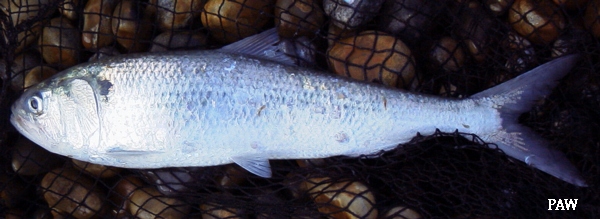Twait Shad
- Also known as: May Fish
- Size: Up to 20ins/50cm in length and 4lb. UK shore caught typically 25cm and 2lbs.
- UK shore caught record: Allis Shad 4lb 120z / Twaite Shad 2lb 12oz [uK record currently suspended due to Endangered status].
- Distribution: Migrates between freshwater and saltwater throughout Europe and North Africa, although numbers are massivley reduced and in the UK the shad is only found in very isolated rivers and estuaries.
- Feeds on: Plankton and tiny invertebrates when young, eats small crustaceans and hunts small fish when older.
- Description: Small, herring like fish. Single dorsal fin and deeply forked tail. Silvery appearance which can be darker on the back and fins. Scales are loose and very large. Spot pattern runs along flanks from gill covers, although this varies vastly between individual fish – in some fish fifteen spots can run all the way to the tail, in others the spots can be absent altogether.
- Additional notes: Not to be confused with Scad.
The two types of shad found in UK waters are the allis shad (Alosa alosa) and the twaite shad (Alosa fallax). These two species are very, very similar, with the main difference being the size (allis shad can grow to almost 5lb, twaite shad just to 2lbs). The only other differences are that allis shad have more than seventy scales along the lateral line and more than ninety gill rakers, whereas twaite shad have less than seventy scales along the lateral line and less gill rakers.
The dark spots on the flanks and tail vary within and between species meaning they cannot be used for identification purposes. The two species can also interbreed, meaning that some shad exist which have numbers of lateral line scales and gill rakers between the figures mentioned above. Due to the close similarities between these species the rest of this article will consider shad as a single species. Life Cycle
Shad are members of the culpeidae family and are closely related to herrings. They are an anadromous fish meaning they can live in both salt and freshwater environments. Mature shad spend their life in the sea, where they feed on small fish such as sprats, lesser sandeel and immature herrings. In spring (usually in the month of May, hence the alternative name of May fish) the shad moves migrates up rivers and into freshwater to breed. Shad can travel hundreds of miles up rivers before they find their breeding grounds. The young shad live in freshwater for some time before they begin to make their way back downstream and towards the sea. Usually shad will have reached the sea by the time they are two years old and live in the sea until they reach sexual maturity at anytime between the age of three and seven. Allis shad can only reproduce once and die after breeding, whereas twaite shad can carry out the journey and reproduce multiple times.
Shad numbers are massively reduced in Britain compared to several decades ago. Overfishing has played a part, although shad had not been a food fish in Britain since the 1800s it is still caught and disposed of as bycatch. However, the biggest cause of the reduction of shad numbersis obstructions built into rivers such as dams, sluices, weirs and pumping stations. These structures have disrupted migratory patterns of shad and been the major cause of decimated shad numbers. A further problem is that these structures are often created to be ‘fish friendly’ and are passable by trout and salmon but cannot be passed by the smaller and weaker shad. Shad also need clean and clear water and pollution has played a part in reducing numbers. Today shad are absent from many areas where they were once abundant. In many major European rivers such as the Rhine, Elbe and Thames the shad is now officially classified as extinct. The last major place of abundant shad is in the north west of France. The rivers Usk, Wye and the River Severn are rare UK rivers where shad are known to spawn, but only remnant populations remain in other major rivers where the shad used to be common.
Legal Protection for Shad
Shad caught by UK sea anglers are usually caught by anglers spinning for bass or using daylights or feathers to go for mackerel. Due to the rarity of this species the shad is subject to substantial legal protection. It is illegal to kill, injure or take a shad from the sea under Section 5 of the Wildlife and Countryside Act (1981). It is therefore not legal to specifically target shad and any shad inadvertently caught must be returned to the sea immediately without injury or harm.



Recommended Comments
There are no comments to display.